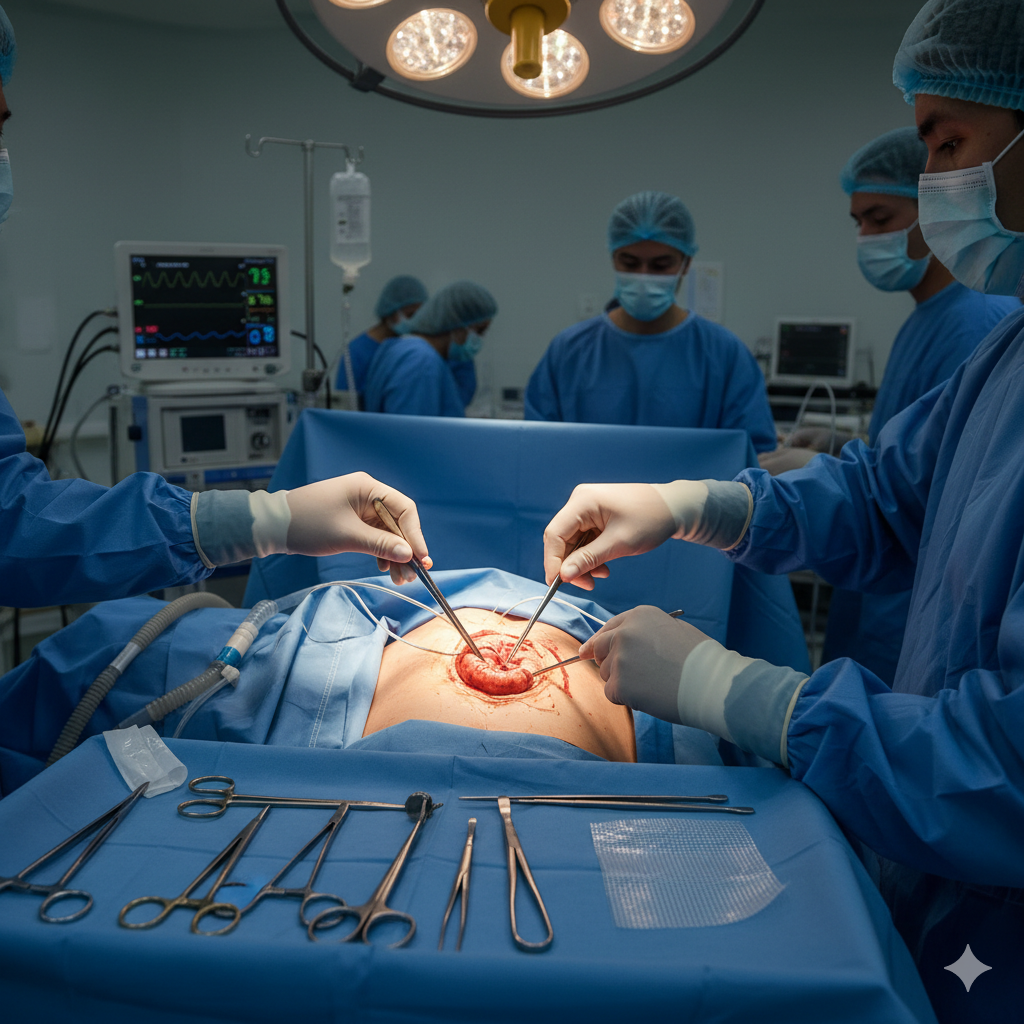
A hernia occurs when an internal organ or tissue pushes through a weak spot in the muscle or surrounding wall that usually holds it in place. In Singapore, hernia surgery is one of the most common general surgical procedures, performed to repair this defect and prevent complications such as pain, discomfort, or strangulation of the affected tissue.
What Is a Hernia?
A hernia develops when part of an internal organ, usually a section of the intestine or fatty tissue, protrudes through a weakened area of muscle or connective tissue. Hernias can occur in various parts of the body, but they most often appear in the abdominal or groin regions.
Common types of hernias include:
- Inguinal hernia – Found in the groin area; most common in men.
- Femoral hernia – Appears just below the groin; more common in women.
- Umbilical hernia – Occurs near the belly button.
- Incisional hernia – Develops at the site of a previous surgical incision.
- Hiatal hernia – Occurs when part of the stomach pushes into the chest cavity through the diaphragm.
While not all hernias are immediately dangerous, they do not heal on their own. Surgical repair is the only definitive treatment to correct the defect and reduce the risk of complications.
When Is Surgery Recommended?
Doctors typically recommend surgery when:
- The hernia causes pain, bulging, or discomfort during daily activities.
- There is a risk of incarceration or strangulation (when trapped tissue loses blood supply).
- The hernia continues to increase in size or interferes with movement.
- Hernia repair surgery is often performed on an elective (planned) basis. Emergency surgery is required if a hernia becomes strangulated, as this can lead to tissue death and serious complications.
Types of Hernia Surgery
There are two main surgical techniques used to repair hernias: open repair and laparoscopic (keyhole) repair. Both aim to return the protruding tissue to its proper position and reinforce the weakened area to prevent recurrence.
1. Open Hernia Repair
In open surgery, the surgeon makes a single incision over the hernia site. The protruding tissue is gently pushed back into place, and the weakened muscle wall is repaired – usually with the help of a synthetic mesh for reinforcement.
Advantages:
- Often performed under local or general anaesthesia
- Suitable for large or complex hernias
- Short operating time
Limitations:
- Larger incision and longer recovery
- Possible post-operative discomfort
2. Laparoscopic Hernia Repair
In laparoscopic surgery, several small incisions are made, and the surgeon uses a camera and instruments to repair the hernia from the inside. A mesh is placed to strengthen the muscle wall.
Advantages:
- Smaller scars
- Shorter recovery period
- Less post-operative pain
Limitations:
- Requires general anaesthesia
- May not be suitable for very large hernias or patients with previous abdominal surgery
Both techniques are widely available in public and private hospitals. The choice depends on the size and type of hernia, the patient’s medical condition, and the surgeon’s recommendation.
The Hernia Surgery Procedure
Before surgery, patients usually undergo a physical examination, medical imaging (such as ultrasound or CT scan), and blood tests to confirm the diagnosis and rule out other conditions.
During the procedure:
- Anaesthesia is administered – local, spinal, or general, depending on the case.
- The surgeon locates and reduces the hernia sac, returning tissues to their normal position.
- The defect is closed and reinforced using sutures and/or mesh.
- The incision sites are closed and dressed.
- The operation typically takes 30 minutes to 1 hour, depending on complexity.
Recovery After Hernia Surgery
Most patients can return home on the same day or the following day, depending on the type of surgery and their overall health.
Recovery timeline (general guidance):
- Day 1–3: Mild soreness around the incision. Light walking is encouraged.
- Week 1–2: Most patients resume normal daily activities.
- Week 3–4: Return to work if not physically demanding.
- Week 6 onwards: Resume exercise or heavy lifting with doctor’s approval.
Post-surgery care usually includes:
- Keeping the wound clean and dry
- Taking prescribed pain medication if needed
- Avoiding heavy lifting for at least 4–6 weeks
- Attending follow-up appointments to ensure proper healing
Possible Risks and Complications
Hernia surgery is generally safe, but like all surgical procedures, it carries some risks. Potential complications include:
- Infection at the surgical site
- Bleeding or bruising
- Recurrence of the hernia
- Chronic pain or numbness near the incision
- Reaction to anaesthesia
- Choosing an experienced surgeon and following post-operative care instructions significantly reduce these risks.
Cost of Hernia Surgery in Singapore
The cost of hernia surgery varies based on:
- Type of procedure (open vs. laparoscopic)
- Choice of hospital (public vs. private)
- Room class and surgeon’s fees
- Extent of hernia and need for mesh repair
As a rough estimate:
- Public hospitals: From around S$3,000–S$6,000 (with subsidies for Singapore citizens and PRs)
- Private hospitals: Around S$6,000–S$12,000, depending on complexity
- Most patients can use MediSave and MediShield Life to offset part of the surgical and hospital costs.
When to Seek Medical Advice
Patients should consult a doctor if they notice:
- A bulge or swelling in the groin or abdomen that increases in size
- Pain, discomfort, or a heavy sensation at the hernia site
- Nausea, vomiting, or severe pain (possible strangulated hernia – a medical emergency)
- Early diagnosis allows for timely treatment and reduces the likelihood of complications.
Conclusion
Hernia surgery is a safe and effective procedure to repair muscle wall defects and restore quality of life. Whether performed through open or laparoscopic methods, the goal is to prevent the hernia from worsening and to reduce symptoms.
Anyone experiencing hernia symptoms should seek medical evaluation from a qualified healthcare professional. Early intervention ensures the best possible outcome and minimizes the risk of emergency surgery.